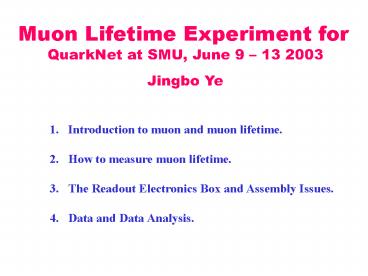Muon Lifetime Experiment for - PowerPoint PPT Presentation
Title:
Muon Lifetime Experiment for
Description:
Muon Lifetime Experiment for QuarkNet at SMU, June 9 13 2003 Jingbo Ye Introduction to muon and muon lifetime. How to measure muon lifetime. The Readout ... – PowerPoint PPT presentation
Number of Views:81
Avg rating:3.0/5.0
Title: Muon Lifetime Experiment for
1
Muon Lifetime Experiment for QuarkNet at SMU,
June 9 13 2003 Jingbo Ye
- Introduction to muon and muon lifetime.
- How to measure muon lifetime.
- The Readout Electronics Box and Assembly Issues.
- Data and Data Analysis.
2
- Introduction to muon and muon lifetime.
We live here
Is made of these
The Universes fundamental building blocks.
3
As physicists, how do we measure these particles?
With facilities no single country can afford!
34 countries in ATLAS
4
Can we at least measure one of those fundamental
particle parameters in a classroom?
At ground level, we have mostly muons from these
cosmic showers. The questions is what can we
measure and how do we measure. Muons decay and
its lifetime is a fundamental particle parameter.
So lets measure muon lifetime.
5
What is a lifetime?
N N0 e t/?
?
By measuring the time difference muon entrance
and the electron production, we can calculate the
muon lifetime ?. So we need a detector to count
a double pulse.
e
?
?
Our Detector
6
2. How to measure muon lifetime.
7
3. The Readout Electronics Box and Assembly
Issues.
Congratulations on yesterdays great job!
TDC (FPGA)
X5
X(-4)
Disc
Vthrd
DC power unit
HV (-1200V) unit
8
- What we do this afternoon
- Debug the boards, download the TDC code.
- Add the HV module.
- Assemble the box into the box, connect the LEDs
and connectors. - Test on the detectors.
We should be able to finish before 5 PM.
9
The Detector Scintillation Detectors Organic,
liquid, plastic Inorganic crystal (sodium
iodide). We use plastic, a good source is
http//eljentechnology.com/ej-200.html with a
quoted price of 372. The may be used plastic
scintillators from HEP and other experiments. If
you have a good source, please let me know. The
cheapest (if new) is liquid scintillator. The
following web page provides a good description on
how to make such a detector yourself
http//www.pma.caltech.edu/ph77/labs/exp15.html
10
(No Transcript)
11
Another way to detect muons and
electrons cherenkov light. In a medium with an
index of refraction of n the light velocity is
c/n. When a charged particle traverses the medium
with velocity larger than the light velocity, so
called Cherenkov light is emitted. The minimum
energy of the particle with this velocity (called
Cherenkov threshold energy'') is 0.768 MeV for
electrons and 158.7 MeV for muons. Cherenkov
light is emitted in a cone of half angle ? from
the direction of the particle track. In water
this angle is about 42o.
12
Light collection PMT A good source I know is
http//www.burle.com/pdf/s83054f.pdf or
s8349S.pdf with a quoted price of 215 for
s83054f. The tubes come with a base attached. I
recommend this as a reading material for
PMTs http//www.burle.com/cgi-bin/byteserver.pl/p
df/Photo.pdf
13
A suggested muon detector based on water
If the container is conductive, try to insolate
the PMT from the container by Tape the
PMT. Leave a few cm air gap between the water
surface and the PMT.
muon
50 to 100 cm 30 cm in D The largest cooking pot
will be a good starting object to work on.
water
electron
14
- Last suggestion
- Check on the internet to see
- What is used in HEP experiments. They usually
have a public link that describes the detector
concepts much better than their collaboration
links. - What other people have tried.
- And then be creative! One can always try things
out, as long as that is physically safe.
15
4. Data and Data Analysis. Data format 40010
1047328747 ?10 muons during this time40005
104732874840010 104732874940004 1047328750900
1047328750 ?one muon decay, 90020 ns40005
104732875140007 104732875240008
104732902740006 104732902840006
104732902917280 1047329029 ?one muon
decay,1728020 ns 40013 104732903040007
1047329031
16
For data analyses One can plot muon decay times
and fit to
N N0 e t/? Nb
To find out the lifetime. Here one needs to be
careful about the flat background.
17
- Expansion (upgrade) under consideration
- The muon box we have now provides
- High voltage to the PMT.
- PMT signal amplification and processing.
- A timer (TDC) that records muon decay time w/ 20
ns precision. - A computer interface (via serial port and USB)
and a DAQ software. - The absolute time stamp on each event relies on
the PC clock, which is only precise down to a few
ms. - Next version
- Add a second channel, or maybe three channels to
perform on-board co-incidence measurement. - Add a GPS time based absolute time stamp, w/ a
precision down to 1 ns. - This will enable us to study shower profile with
many detection units connected through internet.
Please check by next year!































